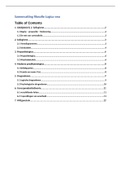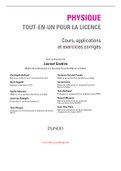Roots of Behavior
Genetics And DNA
Chromosomes Structures in the nucleus of each cell that contain the genes, the
units of hereditary transmission. A human cell has 46 chromosomes arranged in
23 pairs.
Each chromosome contain a single long molecule of DNA
(deoxyribonucleic acid)
DNA The complex molecule that is the constituent of genes
Gene A section of a DNA molecule that contains instructions for how and when to
assemble a protein. Genes are located on chromosomes
Genes
Each cell contains a nucleus – each human nucleus contains 46 chromosomes –
chromosomes carry instructions for how to build and operate a body.
Chromosomes are made up of colled strand of DNA – the DNA molecule has a
double helix shape – the rungs of the double helix are made up of
complementary chains of adenine (A), thymine (T), guanine (G) and cytosine (C).
A-T and C-G pairs
Sex chromosomes: XX of XY
Autosomes: the other 22 pairs
Gene Expression
Within each cell, the genes are not all active all the time (some genes in each cell
are expressed and some are not). The process of gene expression is quite
intricate, controlled by the interaction of an enormous variety of factors.
- These factors work by modifying the biochemical environment inside the
cell, and it’s this intracellular environment that turns specific genes ‘on or
‘off’
o Environment outside the cell
alter biochemistry within a cell
o Timing
Some genes are active early in an organism’s development,
but not later
o Temperature
Nature/nurture distinction is misleading (neither type of influence operates
without the other).
Genotype The complete set of an organism’s genes. The specific sequence of
genes on each of its chromosomes
Phenotype The overt characteristics and behavior of an organism. Genotype+
environmental context
Gene Transmission
In humans, each egg and each sperm contains 23 chromosomes rather than the
normal complement of 46 (i.e. 23 pairs).
1
, It’s a matter of chance which of the mother’s chromosomes (i.e., which
chromosome from each of her pairs). The same is true for the father
Interactions among Genes
Gregor Mendel (1822-1884) observed the results of cross-fertilizing one variety of
plant with another, and from his observations he worked out some basic laws of
genetic inheritance
- A characteristic shaped largely by variation in just one gene
Chromosomes come in pairs, and since genes are located on chromosomes,
genes also come in pairs.
- Each gene occupies a specific position within its chromosome- called the
gene’s locus – and for each gene, there is a partner gene located at the
corresponding locus on the other half of the chromosomal pair.
o Homozygote: if the paired genes are identical
o Heterozygous: if the paired genes are different.
In all cases: the variations of a specific gene are referred to as
alleles of that gene
Allele: An alternative form of specific gene
Dominant A term for a gene that directs the development of a particular
characteristic even when the corresponding gene on the other chromosome is
different – i.e., some other allele
Recessive A term for a gene that directs the development of a particular
characteristic only if the corresponding gen eon the other chromosome matches
it – i.e., is the same allele
Human traits based on a single gene pair: baldness, red-green color
blindness.
Phenylketonuria (PKU) single (recessive) gene can lead to profound mental
retardation
PKU produces far too little of a specific digestive enzyme person
unable to metabolize phenylalanine in the body causes severe
problems in brain development
If there is little phenylalanine in the person’s diet, then this
inability to digest this chemical doesn’t matter at all (PKU
genotype may or may not lead to phenotype of retardation)
Codominant – a relationship in which both genes in the pair affect the
phenotype
- E.g. blood type AB
Incomplete dominance – person with two different alleles will have a
phenotype that’s intermediate between the type favoured by each allele on its
own
- E.g. serotonin transporter gene
o Nerve cells that use serotonin also make a protein, called the
serotonin transporter, whose job is to mop up serotonin after It has
been used to send a massage. The gene that controls the production
of this protein has two alleles that differ in the length of one part of
the gene.
2
, Individual can have the longer allele on both of their copies of
chromosome 17 (a genotype of l/l), or the short allele on both
(a genotype of s/s), or the short allele on one and the long
allele on the other (s/l)
The long allele of this gene is incompletely dominant
over the short allele. As a result, people with l/l produce
more serotonin transport than do people with s/l than
do people with s/s/)
o Serotonin plays a key role in regulating our moods, appetites, and
sleep schedules.
People who produce less of serotonin transporter are at
greater risk for both depression and anxiety and may react
differently to antidepressant medication
Polygenic Inheritance
Polygenic inheritance A pattern in which many genes all influence a single
trait
- The vast majority of an organism’s traits are influenced by many genes
(bipolar disorder, schizophrenia)
- The genes that are part of the polygenic pattern come in pairs, and the
genes within each pair may have the same alleles of different ones. If the
genes are different, then one allele may be dominant or (more likely)
incompletely dominant or codominant
Evolution By Natural Selection
Proximate cause The influences within an organism’s lifetime that led to its
particular traits and behaviors. (The mechanisms, within the organism’s lifetime
that led its phenotype)
Ultimate cause The reasons why, over many years of evolution, a particular
trait or behavior helped members of a population to survive and reproduce
The Principles of Natural Selection
World-changing book, On the Origin of Species 1859
Across the 19th century, it had become clear to scientists that the creatures
populating the planet were markedly different from those that had been
around in earlier epochs (fossil record told them this)
Galapagos Islands.
- Notion: all life on Earth had a shared origin, so that all creatures had
descended from an ancient ancestor. Modern species had emerged –
through some process of modification – from this shared ancestor
- Notion: evolution through natural selection
o Thomas Malthus: living things reproduce rapidly enough so that
populations are always growing – and growing more rapidly than the
food supply is. Consequence is that some will survive, but others
not. that, for Darwin was the key for natural selection
Finch with a wide bill might be better able to crack open
seeds than its narrow-billed fellow
3
, Natural selection The mechanism that drives biological evolution. It
refers to the greater likelihood of successful reproduction for organisms
whose attributed are advantageous in a given environment
o If repeated generation after generation, could produce large change
in a population. Darwin termed these changes transmutation, but
they are now called evolution
Evolutions favors the organism that is better adapted to survive and reproduce
within the environment currently in place. Avoid naturalistic fallacy
Naturalistic fallacy The (mistaken) idea that anything ‘natural’ must be ‘good’.
Or that more recently evolved traits are ‘better’ than those that evolved earlier,
so that natural selection ‘improves’ or ‘advances’ a species.
Evolution is a matter of survival and reproduction – and that’s all
4
,Genes and Evolution
Three principles of Darwin:
1. There must be variation among the individuals within an population
2. Certain of the variant must survive and reproduce at higher rate than
others
3. The traits associated with this superior survival and reproduction must be
passed from parents to offspring
The enormously similar genomes is a large part of what defines the species, and
it’s why member of species all have roughly the same anatomy and physiology.
Reasons why species very in their genotype:
- The random element that’s involved in sexual reproduction (combination of
alleles)
- Mutations Errors in the replication of DNA
o Some do confer an advantage for survival and reproduction
Evolution is often described as ‘survival of the fittest.’ But this phrase is actually
misleading because survival itself is not at all that evolution is about.
Personal survival does matter, but only insofar as it enables the organism
to reproduce and pass along its genes to the next generation
e.g. when predator approached plover’s nest, the mother bird flies a short distance
away and drags a wing, as if she were injured. Leading the predator away from the
nest, with a substantial risk
- We need to think in terms of the gene’s survival, not the individuals
Evidence for Evolution by Natural Selection
Numerous lines of evidence:
- Organisms can be transformed by selective breeding
- We understand in impressive detail how genetic mutations arise, how
genes are transmitted from generation to generation, and how genes
influence an organism’s traits
o Fossilized remains supporting evolution. We can find anatomical
leftover in modern species that reveal the evolutionary past of the
species
- We watch the process of evolution unfolding in various population
The Unity of Life
Darwin’s great idea:
- Idea of natural selection: the process that changes the traits of a
population over time and may eventually create entirely new species
- Starting point for this process: all modern organisms descended, with
modifications overtime, from a common ancestor
o Human’s closest living relatives are the common chimpanzee and
the bonobo
o This extraordinary unity of life is evident in some remarkable
similarities among our planet’s creatures the fact that a jellyfish
gene works just fine inside the cells of a monkey indicates that
monkeys and jellyfish are related baby monkeys that make green
fluorescent protein
5
, o Unity of life is essential to psychology: we learn a great deal about
us by studying them.
all of these advances rest on the strong biological
resemblance between humans and other animals, which is a
result of our common ancestry
The Genetics And Evolution Of Behavior
Darwin firmly believed that all of his claims about natural selection applied both
to organisms’ structural traits (finch’s bill width) and to its behavior traits (like
being a protective parent).
Psychological traits, just like physical features, are part of an animal’s phenotype.
If this phenotype makes it more likely that the animal will survive and reproduce,
then the animal’s genes will be represented in the next generation.
- The genes guide the production of proteins lead to the construction of a
nervous system with a specific design the nervous system, modulated
by other signalling systems (e.g. hormones) and various environmental
influences, makes the behaviors (or capacities or preferences) more likely
If we observe flexibility in a response, or if we see that a behavior is shaped by
learning, we conclude that the behavior depends on the organism’s experience,
not evolution
- False, evolution has in many cases guided an organism toward relatively
well-defined behaviors (courtship dance, specific style of nest building).
Even in these cases, though, evolution has favoured mechanisms that
produce flexibility in how an animal acts
o Natural selection would favour individuals that could shift their
behavior in response to new circumstances and that could rapidly
deploy new skills appropriate for an altered setting
Niche construction The process in which organisms, through their own
behaviors, alter the environment and thus create their own circumstances
A niche refers to all of the factors in an organism’s environment that have
to potential to affect its life. Animals can and do alter this factors; and by
doing so, they alter the opportunities and challenges they face (e.g. building
new shelters)
Ancient humans would have had a substantial surivival advantage if
they were flexible in their behavior, responsive to new cues in the
environment, and able to share information with others. Natural selection
would have favoured innovators, learners and teachers
We often draw important lessons from considerations of the proximate causes of
a behavior, with an emphasis on genetics. Just as often, we can draw insights by
asking about ultimate causes, with an emphasis on evolution. Examples:
- Expressions of emotions – and smiles in particular
- Intelligence
- Sexual reproduction
The Biological Roots of Smiling
Style of communication:
- Species specific Pertaining to just one species. Found only in one species
6






